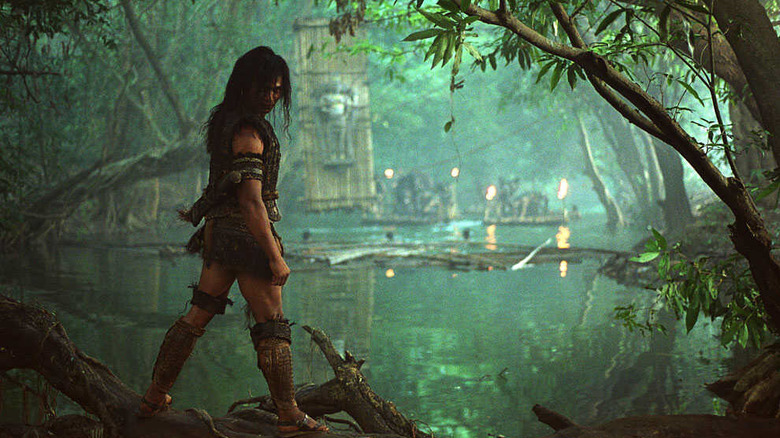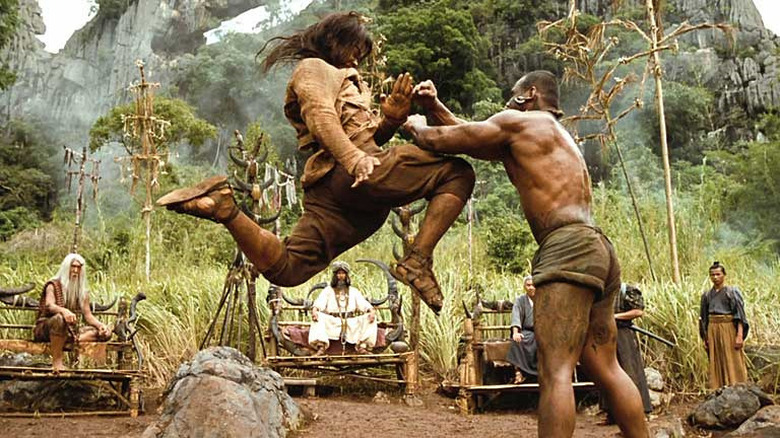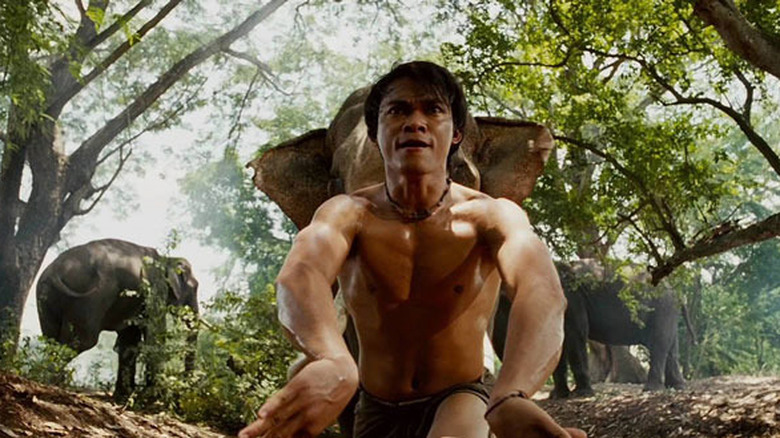Tony Jaa Wanted To Send A Message With His Ong-Bak Sequel
In all of his creative projects, obsession stays due north for Tony Jaa. The martial artist, actor-director, and stuntman registered on mainstream radars worldwide in the Prachya Pinkaew-directed 2003 martial arts hit "Ong Bak," starring as Ting, a pensive warrior tasked to retrieve a sacred Buddhist statue after it was lifted from his Thai village by thugs. While his character tries to practice nonviolence, as a rule, Jaa's fists of fury aren't harmless; he banged and burnt himself up plenty just to get the footage needed for an entertaining thrill ride. Showcasing meticulously choreographed fights and ambitious stuntwork, "Ong Bak" grossed over $20 million on its fragile $1.1 million budget and crystallized into pop culture as one of the most lauded martial arts movies of the new millennium.
On the second go-round, star and now co-director Tony Jaa looked to diverge from the usual action template. The 2008 prequel "Ong Bak 2: The Beginning" is an amalgam of narratives, delivering its revenge-action piecemeal amid flashbacks with mystery and romance keeping things interesting. Spinning those plates in the air was both trial and alchemy for Jaa, who told Vulture:
"I want to give the audience something more, something different than they experienced from 'Ong Bak.' I wanted to make sure 'Ong Bak 2' had dimensions, a good story line and [was] packed with emotion as well as action. It is a challenge having these elements in a film, but the key to this is to keep things in balance and to have good control of the rhythms."
As production ran into trouble on "Ong Bak 2," the feature that would emerge from the delays and friction kept an emotional core of spiritual faith as strong as Ting's.
'I think many people can relate to the concept of faith and karma.'
While the epic "Ong Bak 2" had that "something more, something different" that Jaa wanted, he still adhered to a tried-and-true approach to storytelling to carry him through the rocky road to release. Thai studio Sahamongkol Films greenlit the next chapter, with Jaa picking up from prior director Pinkaew (Jaa would also write, produce, and choreograph). Nearly three-quarters of the picture was shot before a funding scuffle happened between Jaa and the studio, causing Jaa's breakdown and two-month exodus into the jungle. The police had to get involved and a co-director, famed Muay Thai choreographer Panna Rittikrai, would be installed before Jaa returned to complete production. When the film finally did release, leagues beyond its budget in December of 2008, it went on to become the second highest-grossing film of the year in Thailand.
Amid the press notes, Jaa touted a "philosophical action film" that mixed Buddhist teachings with its spinning back-kicks. "I believe it's important for an action film, regardless [of] which country it's from, to have its own philosophy to guide the story," Jaa told Vulture. "Buddhist teaching is what I believe — it's what guided me making this movie. I think many people can relate to the concept of faith and karma."
Faith and karma intersect heavily in "Ong Bak 2," which sees Jaa as a young nobleman whose hero's journey takes him down the path of righteous vengeance after his family is slain by a warlord's clan. The 15th-century warrior, Tien, racks up skills in multiple disciplines spanning regions and eras, from Japanese swordsmanship to Indian hand-to-hand combat, all unified by their most unassuming, energy-harnessing spiritual practices — a ritual dance or a chanted prayer before (and after) the blades fly.
The best fighting is no fighting
Despite having little in common narratively, both "Ong Bak" and "Ong Bak 2: The Beginning" practice what many practitioners would call an elevated form of martial arts, one that's counteractive and overcomes assailants often without fighting much at all. Several of the first film's action sequences feature the Thai warrior on the defensive, his parkour leaps and rapid-fire kicks laboring to escape from rabid opponents assigned to dispatch him. The takedowns usually happen in the "John Wick" fashion, only deployed when all other options have been exhausted.
For Jaa, who found early inspiration in the films of Jackie Chan (whose martial arts turned fight-aversion into near-slapstick physical comedy), de-escalation and deflection are just as crucial to a martial arts tale as any flashier, more primal element. "I tried to create breathtaking and spectacular fight scenes like no other action film," Jaa said. "But the core of this film that we want to convey to audiences is that the ultimate martial arts is not beating everybody but [rather] not having to fight at all."
Where "Ong Bak" focused on the power of community and sacrifice to triumph above tragedy, its successor observes a man consumed by a mission of bloody justice. By the time Tien has cut a swath through thugs and assassins and finds the opportunity to avenge his father's death, it's not the exultant win he expected. But it's all part of the tonal and thematic balance of "Ong Bak 2" and part of Jaa's m.o. in front of and behind the camera: turning the insurmountable into a marvel.


